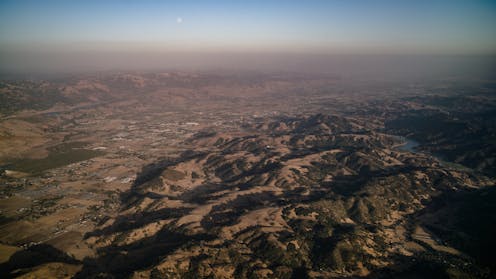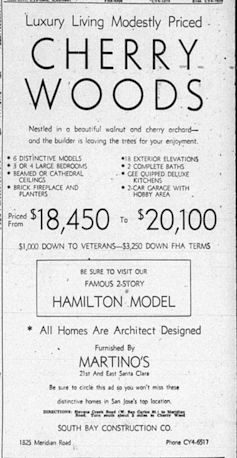How Silicon Valley industry polluted the sylvan California dream
Silicon Valley brought together natural surroundings, suburban homes and futuristic high-tech work. But industrial pollution betrayed the California dream.

On Labor Day 1956, a caravan of moving trucks wound their way into Santa Clara County, just south of San Francisco, carrying the possessions of 600 families and equipment for the missile and space labs of the Lockheed Corporation. One month later, Lockheed’s Sunnyvale campus opened for business. Many of the arriving families were relocating to Sunnyvale from the company’s facility in Burbank, in Southern California.
The draw included good jobs in the emerging businesses of electronics research and development, as well as manufacturing of semiconductors and other electronic components for machinery and computers. Affordable housing, a pastoral landscape and a pleasant environment proved very attractive for newcomers. Local boosters, corporate executives and new residents alike envisioned a modern future in stark contrast with the declining dirty urban industrial model of the Northeast and Midwest.
This type of industrial work and manufacturing didn’t need smokestacks, large warehouses, or other markers of the industrial age. The Santa Clara Valley’s promise for leading Northern California into a bright economic future quickly brought the area the nickname “Silicon Valley.” But in the book I am writing, I note that if this convergence of natural surroundings, suburban homes and high-tech industrialization represented a facet of the California dream, it also betrayed it.
A bright illusion of the future

In addition to jobs in electronics and aerospace, the emerging suburbs of Silicon Valley promised newcomers a countryside experience. David Beers, whose father worked at the Sunnyvale Lockheed campus, remembered the chamber of commerce brochures claiming an “all-year garden” and “the most beautiful valleys in the world.” Such advertisements were common, assuring home buyers “good living,” the “calm of the country” and “a beautiful walnut and cherry orchard” that “the builder is leaving … for your enjoyment.” The white-collar workers of high tech could make their homes in what appeared to be the countryside.
Workplaces, too, were different, with manufacturing happening in places that didn’t look like the old industries of the East. The Stanford Industrial Park, founded in the early 1950s, had strict building guidelines that made it look more like a suburban area than a manufacturing center. Crucially, 60 percent of each lot had to be preserved as open green space, and no smokestacks were allowed. “Everyone thought of smokestacks,” recalled Alf Brandin, Stanford’s business manager in the 1940s and 1950s. “These new people who came out from the East and settled here thought, ‘Don’t change it. We just left all the smoke and all that junk. Don’t change this.’”
The overall feeling was of much more than just a good job and a nice place to live: a new world was opening, based on computing. Promising young engineers could come west, buy a home and work in the future of the nation’s industry. “There’s a sense of being pioneers here,” Mark Leslie, founder of Synapse Computers, told a reporter in 1982. “I view myself as the kind of guy who would have been living in Detroit in 1910. The future depends on high technology, and we are spearheading it.”
Recent college graduates and white-collar workers flocked to the valley to work at companies like Fairchild, Intel, Hewlett-Packard, International Business Machines and Lockheed. The county’s population more than quadrupled in 30 years, from 290,547 in 1950 to 1,265,200 in 1980. But the clean, gleaming future they imagined was already being tarnished.
Fairchild contamination
Semiconductor manufacturing involves very carefully connecting microscopic electrical components to each other on large plates of silicon. Pieces of dust can block sensitive circuits, and the smallest scratches can render everything useless. So to clean the silicon wafers and the parts joined to them, manufacturers used harsh chemical solvents like 1,1,1 trichloroethane, xylene and methanol. These chemicals were stored on-site in containers designed to safely hold them.
But in December 1981, construction workers discovered a leaking chemical solvents tank at Fairchild Semiconductor’s southern San José facility. A cancer-causing chemical, TCE, had found its way into nearby drinking-water wells. The water company promptly shut off pumping water from those wells. A month later, the San Jose Mercury broke the story of the chemical leak. TCE accumulated in wells at nearly 20 times the permissible limit established by the Environmental Protection Agency. Over the course of two years, more than 60,000 gallons of toxic chemicals had leaked from the tank, spreading underground more than half a mile into the surrounding neighborhood of Los Paseos.
Neighbors speak up
For the residents of the Los Paseos neighborhood, just across the street from Fairchild, the news of the chemical leak suddenly explained the stories of birth defects among their neighbors. Lorraine Ross, whose daughter had her first open-heart surgery at nine months old, couldn’t help but wonder if the four birth defects, two miscarriages and one stillbirth of Los Paseos in the past two years were connected to water contamination. She organized others in the neighborhood to ask questions, eventually partnering with a young lawyer, Ted Smith, who founded a new advocacy organization called the Silicon Valley Toxics Coalition. The Silicon Valley Toxics Coalition was designed to advocate for neighborhoods, helping draft new county and city ordinances related to the storage, transportation and disposal of chemicals and gases in Santa Clara County.

News of the Fairchild leak captured the attention of the San Francisco Bay Area. The presence of these chemicals and synthetics were a revelation. “There was no doubt in my mind that this was a clean industry,” remarked San José Mayor Janet Gray Hayes. Lorraine Ross echoed this sentiment, telling a reporter that “we thought we were living with a clean industry.” But it wasn’t true.
Widespread pollution
Fairchild wasn’t alone in leaking pollution into the vibrant environment and thriving communities around its industrial sites. By 1992, one study found that 57 private and 47 public drinking wells were contaminated. Santa Clara County authorities determined that 65 of the 79 companies they investigated had contaminated the soil beneath their facilities. Several companies were forced to pay several million dollars for the cleanup of polluted sites, as well as install new monitoring equipment to prevent leaks for occurring again. Fairchild Semiconductor and other companies in the Los Paseos area found to have contaminated the water agreed to pay a multi-million-dollar settlement to 530 residents in southern San José.
The U.S. Environmental Protection Agency eventually determined 29 polluted sites were eligible for Superfund cleanup money over the course of the 1980s – 24 of which resulted from high-tech industries. Under Superfund, polluted sites that particularly threaten wildlife or human health become eligible for federal funding to help clean up hazardous and contaminated sites. By the end of the 1980s, Santa Clara County had more Superfund sites than any other county in the United States. Twenty-three of the sites remain in remediation today.
By accident and by neglect, the promise of clean industrialization proved elusive. Thousands of people migrated to the Santa Clara Valley hoping to take part in the remarkable convergence of affordable housing and new jobs. And while smokestacks were absent from electronics manufacturing, the presence of highly toxic chemicals – trichloroethane and chlorinated solvents – shattered the illusion behind the tech industry’s green image. The industry permanently altered the land and human bodies.
Jason A. Heppler does not work for, consult, own shares in or receive funding from any company or organization that would benefit from this article, and has disclosed no relevant affiliations beyond their academic appointment.
Read These Next
West Coast levee failures show growing risks from America’s aging flood defenses
Levees protect more than 7 million buildings in the US today, yet they got a D-plus grade in 2025. A…
LA fires showed how much neighborliness matters for wildfire safety – schools can do much more to te
Managing fire risk is about more than regulations and rules. It’s also about caring for neighbors…
Has the Fed fixed the economy yet? And other burning economic questions for 2026
As 2026 begins, uncertainty is at the top of everyone’s mind.






